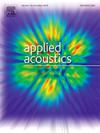A novel two-stage DOA estimation of sound sources based on hierarchical sparse Bayesian inference
IF 3.4
2区 物理与天体物理
Q1 ACOUSTICS
引用次数: 0
Abstract
To efficiently achieve off-grid sparse Bayesian direction-of-arrival (DOA) estimation for sound sources, this paper proposes a two-stage off-grid DOA estimation method based on a hierarchical sparse Bayesian inference (HSBI) framework. In the first stage, the proposed HSBI model utilizes a Gaussian distribution to form a sparse representation of sound sources in space, and a Laplace distribution to enhance sparsity in intermediate parameters during Bayesian inference. This stage provides initial estimates of the unknown sound source positions, serving as the foundation for the second stage. In the second stage, a novel particle swarm optimization (PSO)-based high-precision DOA solver is proposed. This solver leverages spatial beamforming theory to efficiently search for the maximum energy distribution in the physical space, yielding accurate sound source position estimates at high speed. The HSBI model exhibits superior sparsity performance, allowing for precise estimation of unknown sound sources while preventing the PSO solver from becoming trapped in local optima. Simulation and experimental results show that the PSO-HSBI algorithm achieves efficient sound source DOA estimation with low computational complexity, while significantly reducing amplitude and localization errors. The source code for the proposed PSO-HSBI algorithm is available at https://github.com/Xiaob0-Zhang/PSO-HSBI.
求助全文
约1分钟内获得全文
求助全文
来源期刊

Applied Acoustics
物理-声学
CiteScore
7.40
自引率
11.80%
发文量
618
审稿时长
7.5 months
期刊介绍:
Since its launch in 1968, Applied Acoustics has been publishing high quality research papers providing state-of-the-art coverage of research findings for engineers and scientists involved in applications of acoustics in the widest sense.
Applied Acoustics looks not only at recent developments in the understanding of acoustics but also at ways of exploiting that understanding. The Journal aims to encourage the exchange of practical experience through publication and in so doing creates a fund of technological information that can be used for solving related problems. The presentation of information in graphical or tabular form is especially encouraged. If a report of a mathematical development is a necessary part of a paper it is important to ensure that it is there only as an integral part of a practical solution to a problem and is supported by data. Applied Acoustics encourages the exchange of practical experience in the following ways: • Complete Papers • Short Technical Notes • Review Articles; and thereby provides a wealth of technological information that can be used to solve related problems.
Manuscripts that address all fields of applications of acoustics ranging from medicine and NDT to the environment and buildings are welcome.
 求助内容:
求助内容: 应助结果提醒方式:
应助结果提醒方式:


